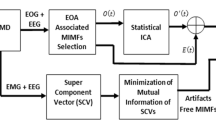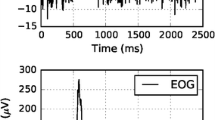Abstract
Electroencephalogram (EEG) signals are often corrupted by undesirable sources like electrooculogram (EOG) artifacts, which have a substantial impact on the performance of EEG-based systems. This study proposes a new singular spectrum analysis (SSA)–non-negative matrix factorization (NMF)-based ocular artifact removal (SNOAR) method to suppress ocular artifacts from multi-channel EEG signals. First, SSA was used to estimate EOG artifacts using a small subset of frontal electrodes. Then, NMF was applied to decompose the estimated EOG artifacts into vertical EOG (VEOG) and horizontal EOG (HEOG) signals. Finally, a simple linear regression with estimated VEOG and HEOG signals was used to remove artifacts from multi-channel EEG signals. EEG recordings from two EEG datasets (Klados dataset and KARA ONE) were used to evaluate the efficiency of the proposed method. From the simulation results, it was observed that the proposed method achieved betters results in terms of low root-mean-square error (RMSE), low delta band energy ratio, and less power spectral density (PSD) difference between the original clean EEG signal and its filtered version of contaminated EEG signal compared to selected EOG artifact removal methods (independent component analysis (ICA), wavelet-enhanced ICA (wICA), improved wICA, and multivariate empirical mode decomposition (MEMD)).
Graphical abstract













Similar content being viewed by others
References
Jiang X, Bian G, Tian Z (2019) Removal of artifacts from EEG signals: a review. In Sensors 19(5):987. https://doi.org/10.3390/s19050987
Croft RJ, Barry RJ (2000) Removal of ocular artifact from the EEG: a review. In Neurophysiologie Clinique 30(1):5–19. https://doi.org/10.1016/S0987-7053(00)00055-1
Wallstrom GL, Kass RE, Miller A, Cohn JF, Fox NA (2004) Automatic correction of ocular artifacts in the EEG: a comparison of regression-based and component-based methods. International Journal of Psychophysiology 53(2):105–119. https://doi.org/10.1016/j.ijpsycho.2004.03.007
Mumtaz W, Rasheed S, Irfan A (2021) Review of challenges associated with the EEG artifact removal methods. Biomed Signal Process Control 68:102741. https://doi.org/10.1016/j.bspc.2021.102741
Klados MA, Bamidis PD (2016) A semi-simulated EEG/EOG dataset for the comparison of EOG artifact rejection techniques. Data Brief 8:1004–1006. https://doi.org/10.1016/j.dib.2016.06.032
Zhao S, Rudzicz F (2015) Classifying phonological categories in imagined and articulated speech. In: IEEE International Conference on Acoustics, Speech and Signal Processing, 922–996. https://doi.org/10.1109/ICASSP.2015.7178118
Ranjan R, Sahana BC, Bhandari AK (2021) Ocular artifact elimination from electroencephalography signals: a systematic review. Biocybernetics and Biomedical Engineering 41(3):960–996
He P, Wilson G, Russell C (2004) Removal of ocular artifacts from electro-encephalogram by adaptive filtering. Med Biol Eng Compu 42(3):407–412. https://doi.org/10.1007/BF02344717
Somers B, Francart T, Bertrand A (2018) A generic EEG artifact removal algorithm based on the multi-channel Wiener filter. J Neural Eng 15(3):036007. https://doi.org/10.1088/1741-2552/aaac92
Castellanos NP, Makarov VA (2006) Recovering EEG brain signals: artifact suppression with wavelet enhanced independent component analysis. J Neurosci Methods 158(2):300–312. https://doi.org/10.1016/j.jneumeth.2006.05.033
Inuso G, La Foresta F, Mammone N, Morabito F C(2007) Wavelet-ICA methodology for efficient artifact removal from Electroencephalographic recordings. In: International Conference on Neural Networks - Conference Proceedings. IEEE, pp 1524–1529. https://doi.org/10.1109/IJCNN.2007.4371184
Molla MKI, Tanaka T, Rutkowski TM (2012) Multivariate EMD based approach to EOG artifacts separation from EEG. In: International Conference on Acoustics, Speech and Signal Processing. IEEE, pp 653–656. https://doi.org/10.1109/ICASSP.2012.6287968
Molla Md KI, Tanaka T, Rutkowski TM, Cichocki A (2010) Separation of EOG artifacts from EEG signals using Bivariate EMD. In: International Conference on Acoustics, Speech and Signal Processing. IEEE, pp 562–565. https://doi.org/10.1109/ICASS P.2010.5495594
Damon C, Liutkus A, Gramfort A, Essid S (2013) Non-negative matrix factorization for single-channel EEG artifact rejection. In: International Conference on Acoustics Speech and Signal Processing. IEEE, pp 1177–1181. https://doi.org/10.1109/ICASSP. 2013. 6637836
Gu Y, Li X, Chen S, Li X (2021) AOAR: an automatic ocular artifact removal approach for multi-channel electroencephalogram data based on non-negative matrix factorization and empirical mode decomposition. J Neural Eng 18(5):056012. https://doi.org/10.1088/1741-2552/abede0
Maddirala AK, Shaik RA (2016) Removal of EOG artifacts from single channel EEG signals using combined singular spectrum analysis and adaptive noise canceler. IEEE Sens J 16(23):8279–8287. https://doi.org/10.1109/JSEN.2016.2560219
Noorbasha SK, Sudha GF (2020) Removal of EOG artifacts from single channel EEG – an efficient model combining overlap segmented ASSA and ANC. Biomed Signal Process Control 60:101987. https://doi.org/10.1016/j.bspc.2020.101987
Noorbasha SK, Sudha GF (2021) Removal of EOG artifacts and separation of different cerebral activity components from single channel EEG—an efficient approach combining SSA–ICA with wavelet thresholding for BCI applications. Biomed Signal Process Control 63:102168. https://doi.org/10.1016/j.bspc.2020.102168
Maddirala AK, Veluvolu KC (2021) Eye-blink artifact removal from single channel EEG with k-means and SSA. Sci Rep 11(1):1–4
Patel R, Sengottuvel S, Janawadkar MP, Gireesan K, Radhakrishnan TS, Mariyappa N (2016) Ocular artifact suppression from EEG using ensemble empirical mode decomposition with principal component analysis. Comput Electr Eng 60:101987. https://doi.org/10.1016/j.compeleceng.2015.08.019
Kanoga S, Mitsukura Y (2015) Eye blink artifact rejection in single-channel electroence-phalographic signals by complete ensemble empirical mode decomposition and independent component analysis. In: Annual International Conference of the IEEE Engineering in Medicine and Biology Society. IEEE, pp 121–124. https://doi.org/10.1109/EMBC.2015.7318315
Sweeney KT, McLoone SF, Ward TE (2013) The use of ensemble empirical mode decomposition with canonical correlation analysis as a novel artifact removal technique. IEEE Trans Biomed Eng 60(1):97–105. https://doi.org/10.1109/TBME.2012.2225427
Saini M, Payal SU (2020) An effective and robust framework for ocular artifact removal from single-channel EEG Signal based on variational mode decomposition. IEEE Sens J 20(1):369–376
Gajbhiye P, Tripathy RK, Pachori RB (2020) Elimination of ocular artifacts from single channel EEG signals using FBSE-EWT based rhythms. IEEE Sens J 20(7):3687–3696. https://doi.org/10.1109/JSEN.2019.2959697
Hassani H, Zhigljavsky A (2009) Singular spectrum analysis: methodology and application to economics data. J Syst Sci Complexity 22(3):372–394. https://doi.org/10.1007/s11424-009-9171-9
Naik GR (2015) Non-negative matrix factorization techniques: advances in theory and applications. In Non-negative matrix factorization techniques: advances in theory and applications. https://doi.org/10.1007/978-3-662-48331-2
Issa MF, Juhasz Z (2019) Improved EOG artifact removal using wavelet enhanced independent component analysis. Brain Sci 9(12):355. https://doi.org/10.3390/brainsci9120355
Acknowledgements
The first author acknowledges the support from the Ministry of Education, Government of India. The second and third authors acknowledge the financial grant received from Core Research Grant of the Science and Engineering Research Board (SERB), Department of Science and Technology (DST), Government of India (CRG/2021/007147).
Author information
Authors and Affiliations
Contributions
Ruchi Juyal, methodology, software, investigation, and writing — original draft. Hariharan Muthusamy, conceptualization, investigation, writing — review and critical revision of the manuscript, validation, and supervision. Niraj Kumar, conceptualization, writing — review and critical revision of the manuscript, and supervision. All authors approved the final version of the manuscript.
Corresponding author
Ethics declarations
Conflict of interest
The authors declare no competing interests.
Additional information
Publisher's note
Springer Nature remains neutral with regard to jurisdictional claims in published maps and institutional affiliations.
Rights and permissions
Springer Nature or its licensor holds exclusive rights to this article under a publishing agreement with the author(s) or other rightsholder(s); author self-archiving of the accepted manuscript version of this article is solely governed by the terms of such publishing agreement and applicable law.
About this article
Cite this article
Juyal, R., Muthusamy, H. & Kumar, N. SNOAR: a new regression approach for the removal of ocular artifact from multi-channel electroencephalogram signals. Med Biol Eng Comput 60, 3567–3583 (2022). https://doi.org/10.1007/s11517-022-02692-z
Received:
Accepted:
Published:
Issue Date:
DOI: https://doi.org/10.1007/s11517-022-02692-z





